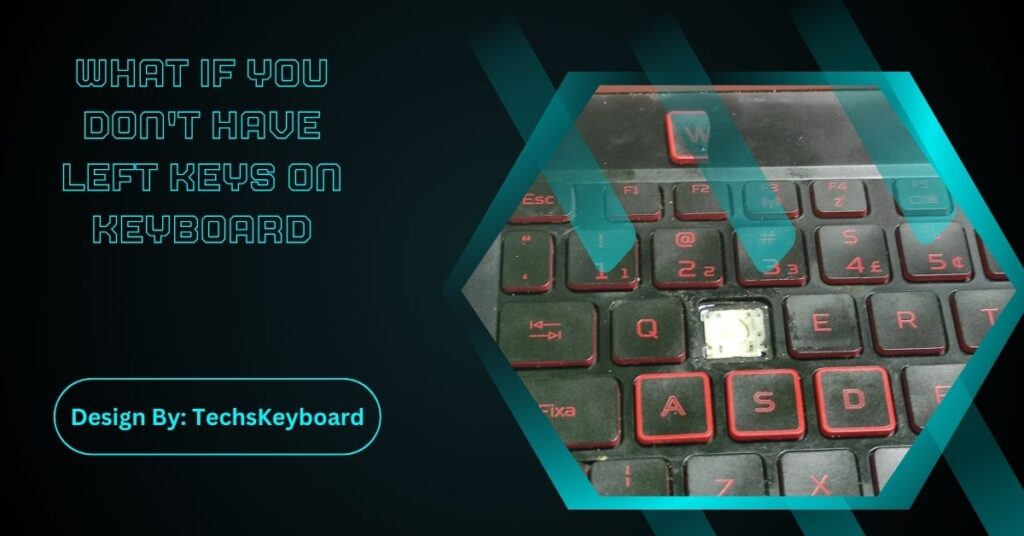If your keyboard’s left keys stop working, it could be due to physical debris, software issues, incorrect settings, or hardware failure. Try cleaning, updating drivers, or testing it on another device.
Have you ever faced a situation where the left keys on your keyboard stop working or become unresponsive? This can be frustrating, as essential keys like Ctrl, Shift, A, S, D, and Caps Lock are commonly used for tasks like typing, gaming, and shortcuts.
In this article, we’ll explore possible reasons for this issue and provide easy-to-follow solutions to get your keyboard back to full functionality.
1. Common Causes of Non-Working Left Keys:
There are several potential reasons your left-side keys might stop working. Identifying the cause is crucial for finding the right fix.
Physical Damage or Debris
Keyboards often collect dust, food crumbs, or small debris over time, which can get stuck under the keys and prevent them from functioning properly. Physical damage, like spilling liquid or dropping the keyboard, can also lead to malfunctioning keys.
Software or Driver Issues
Sometimes, the problem may not be physical. If your keyboard drivers are outdated, corrupted, or misconfigured, it could result in certain keys, like those on the left side, becoming unresponsive.
Faulty Keyboard Settings
Keyboard settings can be accidentally changed, especially if someone has been experimenting with language inputs or keyboard layouts. If the layout is switched, some keys may stop working as expected.
Hardware Malfunction
If your keyboard is older or heavily used, internal wear and tear could be affecting specific keys. In this case, the issue may be with the circuit inside the keyboard.
2. How to Fix Non-Working Left Keys?

Now that we’ve identified some common causes, let’s move on to the solutions. Depending on the source of the problem, the fix could be as simple as cleaning your keyboard or updating a driver.
Clean the Keyboard
Dirt and debris trapped under the keys can cause them to stick or stop working. Here’s how to clean it:
- Turn off or disconnect the keyboard from your computer.
- Use compressed air to blow out debris between the keys.
- Gently tap the keyboard upside down to remove any loose particles.
- Use a soft cloth with a little rubbing alcohol to clean the surface.
If you’re comfortable, you can remove the keycaps (if the keyboard allows it) to clean underneath. After cleaning, test the keys to see if they’re working.
Update or Reinstall Keyboard Drivers
If the issue is related to software or drivers, updating or reinstalling them could resolve the problem.
- Go to your computer’s Device Manager.
- Locate the Keyboard section, and right-click your keyboard driver.
- Select Update driver to check for new updates.
- If updating doesn’t work, you can also try Uninstall device and then restart your computer. The system should automatically reinstall the driver.
Check Keyboard Settings
Sometimes, incorrect settings can cause key malfunctions. Here’s how to check your keyboard settings:
- Go to your computer’s Control Panel or Settings.
- Find Time & Language and click Language Settings.
- Ensure your keyboard layout is correct (e.g., US QWERTY).
- If any accessibility settings like Sticky Keys or Filter Keys are on, turn them off, as they can interfere with normal keyboard function.
Try a Different USB Port or Reset Bluetooth Connection
If you’re using a wired keyboard, try plugging it into a different USB port. For wireless keyboards, try reconnecting the Bluetooth connection by removing and repairing the device.
Test the Keyboard on Another Device
To rule out whether the issue is with the keyboard or your computer, try connecting your keyboard to another device. If it works on a different computer or laptop, the problem might lie with your current device’s software or settings.
3. When to Consider Replacing Your Keyboard?
If none of the solutions above work, the issue could be with the hardware. Sometimes, keyboards wear out due to extended use or damage. Here are signs that it may be time for a replacement:
- Multiple keys stop working or respond inconsistently.
- You notice visible damage to the keyboard.
- The keyboard is very old, and issues have become frequent.
If you decide to replace the keyboard, ensure you choose one that fits your needs, whether it’s for gaming, typing, or general use. You can also consider ergonomic keyboards if you spend long hours typing.
Also Read: Where To Sell Keyboard Piano – Best Platforms & Tips for a Successful Sale!
4. Prevention Tips: How to Avoid Future Issues:
Once your keyboard is back to working order, it’s a good idea to take steps to prevent future problems. Here are some helpful tips to keep your keyboard in good shape:
Regular Cleaning
Make a habit of cleaning your keyboard regularly. Wipe it down weekly, and use compressed air to blow out dust and debris.
Avoid Eating or Drinking Near the Keyboard
Food crumbs and liquid spills are common causes of malfunctioning keyboards. Try to avoid snacking or drinking near your workspace to prevent accidents.
Use a Keyboard Cover
A keyboard cover can protect your keys from dust and spills, keeping them in better working condition for a longer period.
Store Your Keyboard Properly
If you’re not using your keyboard for an extended period, store it in a safe place to avoid dust buildup and potential physical damage.
Left Side Of Keyboard Not Working
If the left side of your keyboard suddenly stops working, it could indicate a hardware fault, dust buildup, or a connection issue. Start by checking for debris under the keys or testing the keyboard on another device. A corrupted keyboard driver or outdated firmware can also cause this issue. For wireless keyboards, low battery or interference might be the culprit. Identifying the exact cause can help you choose between cleaning, updating drivers, or replacing the keyboard altogether.
FAQs:
1. Why are the left keys on my keyboard not working?
Left keys may stop working due to dirt, debris, outdated drivers, incorrect keyboard settings, or hardware malfunction. Troubleshooting can help identify and fix the issue.
2. How do I clean my keyboard to fix stuck keys?
Turn off the keyboard, use compressed air to remove debris, tap it upside down, and gently wipe it with a soft cloth. For deeper cleaning, remove the keycaps if possible.
3. Can updating drivers fix unresponsive keyboard keys?
Yes, updating or reinstalling your keyboard drivers can resolve software-related issues that cause certain keys to stop working.
4. How do I check if my keyboard settings are causing problems?
Go to your device’s settings, check the language and keyboard layout, and disable accessibility features like Sticky Keys that may interfere with key function.
5. When should I replace my keyboard?
Consider replacing your keyboard if multiple keys frequently stop working, there’s visible damage, or if the keyboard is old and performance issues are consistent.
Conclusion:
If the left keys on your keyboard aren’t working, it’s often fixable through cleaning, updating drivers, or checking settings. Physical wear or hardware issues may require a replacement, especially if the keyboard is old or damaged. Regular maintenance like cleaning, avoiding food or drinks near the keyboard, and using a keyboard cover can prevent future issues and extend your keyboard’s lifespan.


